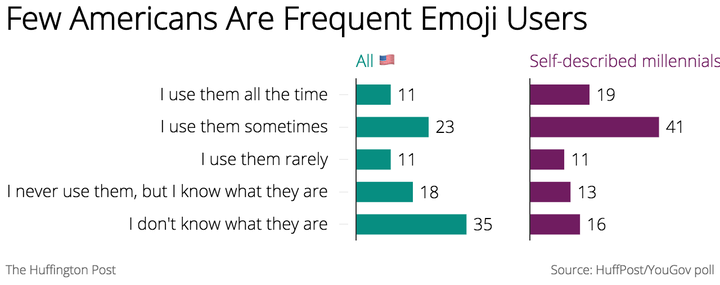In all likelihood, no one needed a survey to tell them that Hillary Clinton's request for emoji-based responses to student loan debt didn't really go that well.
But now we have empirical proof that the roasting was well-deserved. In a new HuffPost/YouGov poll -- conducted, naturally, using emojis -- just 17 percent of Americans gave a 👍 to candidates using the symbols in their emails or on social media, while 47 percent said 👎 and the remainder were like ¯\_(ツ)_/¯.
Clinton's callout, like candidates' use of Snapchat, was presumably an attempt at outreach toward millennials, the much-maligned demographic group renowned for its love of social media and ambivalence about showing up to vote. But even among the fifth or so of Americans who consider themselves millennials (which includes 58 percent of those ages 18-29 and, bafflingly, 6 percent of those older than 65), the reaction was less than 👏 .
While 31 percent of self-described millennials said 👍 to the idea of candidates using emojis in emails or on social media, the majority, 54 percent, still gave the idea a resounding 👎.

Clinton's team, apparently, got the message:
Americans' own emoji use remains modest. Just a third of people in the poll said they use emojis sometimes or all the time, while 31 percent use them rarely or never, and 35 percent weren't sure what they were. Sixty percent of self-described millennials said they at least sometimes use emojis, but just 19 percent classified themselves as frequent users.

The survey didn't ask respondents how they felt about seeing emojis in a survey. But their hostility toward politicians using emojis doesn't extend toward businesses: Thirty-one percent of respondents said 👍 to emojis in advertising or corporate social media, while just 28 percent said 👎. More than half of millennials were on board with that idea.
Maybe people hold candidates for office to a higher standard. Or maybe they're just fed up with campaigning in general: Just 15 percent of Americans say they're 😀 about the 2016 election, while 49 percent are 😐 and 25 percent are actively 😡.
The HuffPost/YouGov 📊 consisted of 1,000 completed 💬 s conducted among 🇺🇸 👥, using a sample selected from YouGov's opt-in 💻 panel to match the demographics and other characteristics of the adult 🇺🇸 population.
The Huffington Post has teamed 🔼 with YouGov to conduct 📅 opinion 📊. You can learn more about this project and take part in YouGov's nationally representative opinion 📊 . Data from all HuffPost/YouGov 📊 can be found here. More details on the 📊 's methodology are available here.
Most 📊 s report a margin of error that represents some, but not 💯, potential survey errors. YouGov's reports include a model-based margin of error, which rests on a specific set of statistical assumptions about the selected sample, rather than the standard methodology for random probability sampling. If these assumptions are❌, the model-based margin of error may also be❌ . Click here for a more detailed explanation of the model-based margin of error.
